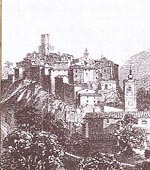| TOURRETTE-LEVENS> HISTOIRE> ORIGIN of name > A GLIMPSE INTO THE PAST > THE CHABAUD> THECANUBIO> |
TOURRETTE-LEVENS
 |
Derived
from a dimunitive of the Latin word Turris (tower, fortified point).
|
|
For several millenia, the rocky outcrop where the château is now situated wasone of the checkpoints on the famous Salt Road, a necessary passage between the port of Nice, Turin, and Piedmont through the Vésubie Valley and the Fenestre Pass. Numerous remains and relics dating to the time of the Roman Empire bear witness to the importance of Tourrette-Levens during that era. A temple was constructed on the site of the château, but was razed along with all of the region’s other structures when the Lombards invaded at the end of the 6th century. The château was constructed during the 12th century by Raymond Chabaud, whose family would hold the fief until 1684. The château at that time, with six towers, three round and three square, was one of the most beautiful in the region. Partially in ruins, the old village dates back to the same century. Its Chapelle des Pénitents Blancs features one of the two triangular steeples in the county. The town is developing rapidly; from 300 inhabitants during the middle ages, the population surpassed 1000 at the beginning of the 20th century, and is presently at 4156. Tourrette-Levens is now the most populated town in the canton of Levens. |
The Lords Chabaud of Tourrette
The Chabaud family controlled the fief of Tourrette from 1175 until 1684. Thus for five centuries, it directed life in the Tourrettan community. Over the years, the Chabauds in control of Tourrette and the fief of Revel witnessed the breakup of their domain through inheritances, due to the absence of a system of birthright. The family tried to preserve the inheritance, particularly by encouraging the youngest sons to take holy orders. This explains the great number of Knights of St. John of Jerusalem that later became the Order of Malta. The estate was reconstituted in its entirety only at the death of Henri de Chabaud in 1645, but it would not remain in the family for long. His grandson Honoré IV died in Tourrette in 1684 without a legitimate child, and the fief passed on to his heiress Marianne Peyrani, a grand niece.
|
|
The Lords Canubio of Tourrette
|
|
| In 1697, Marie-Anne
Peyrani married the Vassal François Marie Canubio di Torricella. The
latter, a native of Cuneo, the capital of Piedmont, was the descendant of a family that
claimed seigneurial rights to Torricella near Céva and to some parts of Deonte. But François Marie was murdered in 1714 and
Marie-Anne died in 1758. With their son Victor Félix began a long legal struggle in
France for the estates of the region of Bordeaux and with the town of Tourrette-Levens.
The French Revolution did away with the fief, but the Canubio family continued to carry
the title of Count of Tourrette in Italy.
On May 8, 1829 the Canubio heirs who still lived in Cuneo sold the château of Tourrette, or rather the ruins that remained, to Louis Carles, a lawyer in Tourrette. The price was 450 pounds, plus the lifelong obligation to celebrate an annual Mass in Tourrette’s church.
|
|
| Saint
Rosalie has been the highly revered patron saint of Tourrette since she protected the
village from the plague of 1631. She is commemorated every September 4, a day upon which
the inhabitants gather around the church dedicated to her. The banquet held the day of the
celebration, whichever day of the week it may fall on, is probably the most important in
the region. Rosalie (1130-1160) was the niece
of the King of Sicily, William II. Originally from Palermo, she sequestered herself in a
cave of Mt. Pelligrino near Palermo, where she lived as a recluse. According to the
tradition, angels brought her a crown of roses.
Forgetten through the Middle Ages, St. Rosalie did not become popular until the time of the Counter-Reformation. Her bones, found by a hunter in 1624, were transported to the cathedral of Palermo and placed in a silver sarcophagus. The exhibition of these relics put an immediate end to the plague that was desolating the city. From the time of the epidemic of 1631, Nice, like Tourrette-Levens, placed itself under the protection of St. Rosalie. On September 4, 1631, the grateful city council of Nice vowed to hold an annual procession to commemorate its delivery from the plague thanks to St. Rosalie’s intercession. A delegation from the council was sent to Palermo to obtain a portion of the relics of the Saint to be conserved in the cathedral, and a part to be put away in Tourrette.
|
|
Mairie de Tourrette-Levens | Tél. 04 93
91 00 16 | Fax 04 93 79 43 11
|
mairie.tourrette.levens@wanadoo.fr |